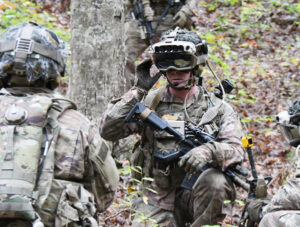The Army is prepared to hold a new competition for its Integrated Visual Augmentation System (IVAS) if testing of Microsoft’s [MSFT] new “1.2” version of the headset later this year is unsuccessful, the service’s top acquisition official said Tuesday.
“Institutionally for the Army, that’s always a hard decision to admit we can’t succeed somewhere. But this is a potential area where, look, if the testing doesn’t prove out very quickly that it’s capable and going to get us what we need, the Army is absolutely prepared to end that arrangement and seek a new competition,” Doug Bush, the assistant secretary of the Army for acquisition, logistics and technology, said during a Senate Armed Services Airland Subcommittee hearing.

In March 2021, the Army awarded Microsoft a deal worth up to $21.9 billion over the next 10 years to move the IVAS augmented reality headset program from rapid prototyping into production (Defense Daily, March 31 2021).
Following an operational test with the initial 1.0 version of IVAS last June, Army officials detailed a plan to adjust the program’s timeline to address reliability, low-light sensor performance and form factor issues identified during the evaluation.
In early January, the Army awarded Microsoft a $125 million deal to work on developing IVAS 1.2, which it said would include a new form factor and software improvements, with a goal to begin testing the upgraded system this fall (Defense Daily, Jan. 9).
“We did a very difficult test with [IVAS 1.0] and we found all the problems. While that’s good that we found the problems, it’s still disappointing and not the outcome that we were looking for,” Bush told the panel. “Our ability to restructure that program on the fly here very quickly to try to get to 1.2 is because of the new authorities we’re using. That would have been almost impossible under a traditional system.”
The Army’s FY ‘24 budget request included $165 million for IVAS, covering $76 million for further development of the new “1.2” version of the headset and $89 million to procure the upgraded system (Defense Daily, March 14).
Production of the new IVAS 1.2 is expected to begin in late FY ‘24 if testing is successful, the Army has said, with an aim for fielding to operational units by late FY ‘25.
The Army’s nearly $2 billion FY ‘24 unfunded priorities list submitted to Congress includes $98 million for IVAS procurement and $22.4 million for further development of the 1.2 system (Defense Daily, March 29).
When asked about the request, Bush said the additional funding would allow the Army to go “a little faster” on starting IVAS 1.2 production if testing proves successful later this year.
“I think we are taking a deliberate approach whereas the first time around was honestly very, very aggressive on timeline and production ramp up. This time we are being more cautious. We want to make sure Microsoft [knows] they have to deliver. This 1.2 system has to be exactly what the Army needs or we’re not going to produce it,” Bush said.
Gen. James Rainey, head of Army Futures Command, told lawmakers he’s “very confident” in the path for IVAS 1.2 and is incorporating feedback from soldiers into its development.
“We’re working with Microsoft so we have the users working hand-in-hand as we develop the [1.2 system]. And we’re going to get it and we’re going to test it with real warfighters and get that soldier feedback,” Rainey said.